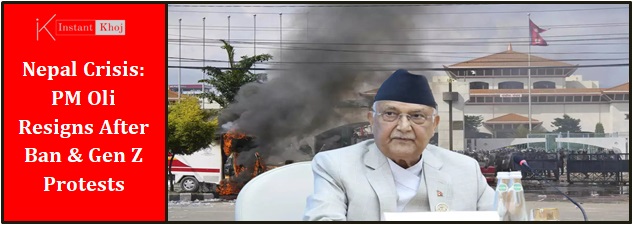Nepal once again witnessed a seismic shift when Prime Minister KP Sharma Oli resigned on September 9, 2025. The resignation came amidst escalating nationwide protests powered by Generation Z, triggered by the government’s controversial ban on over two dozen social media platforms, and fueled by long-standing frustrations over corruption, unemployment, and political stagnancy.
Let’s unpack this complex chapter in Nepal’s history in a clear, reader-friendly manner.
The Spark: Social Media Ban and the Flames of Discontent
In an abrupt move, the Nepalese government blocked 26 major platforms—including Facebook, WhatsApp, YouTube, X, Threads, and more—citing their refusal to register locally and comply with new regulatory laws. The sweeping ban sparked outrage, especially among the youth who depend on these platforms for communication, learning, and activism.
The ban became a tinderbox, quickly inflaming existing resentment over corruption, nepotism, and lack of economic opportunity. Social media—once stifled—became the backbone of protest coordination through encrypted apps and alternate platforms like TikTok and Viber.
Gen Z Takes to the Streets: A Movement with Momentum
With urgency and symbolism, Gen Z rallied across Nepal. Crowds swelled in Kathmandu and various cities with youthful zeal, often in school uniforms. They chanted messages like “Ban social media, not corruption” and “KP Chor, Desh Chhod” (KP thief, leave the country).
Violent scenes soon emerged—properties torched, including Parliament, residences of senior leaders, and public offices. As anger grew, so did tensions, leading to 19 protesters killed and hundreds injured in clashes with security forces using tear gas, bullets, and water cannons.
A Wave of Resignations and the Fall of a Leader
In quick succession, several key cabinet figures resigned:
-
Home Minister Ramesh Lekhak, citing moral responsibility for civilian deaths.
-
Agriculture Minister Ramnath Adhikari, condemning the authoritarian response.
Despite initial resistance, the government lifted the social media ban—but it was too late. The fury and momentum carried on. KP Sharma Oli formally resigned, citing the need to resolve the crisis constitutionally. As protesters celebrated, the Army declared curfews and sought to restore order.
The Aftermath: Calm After the Storm or Seeds of Change?
Following Oli’s resignation:
-
Political chaos persisted, with the Army calling for dialogue and control over security.
-
Kathmandu Mayor Balendra Shah, a former rapper and engineer, emerged as a voice of Gen Z, urged to shape a transitional authority.
Protesters escalated their demands:
-
Constitutional rewrite or reform involving experts and youth.
-
Investigation into looted assets, especially from political elites.
-
Recognition of protest deaths as martyrs with state honors.
-
Institutional reforms spanning justice, education, and communications.
Why this Movement Resonated Deeply
This is more than political upheaval—it’s a generational demand for accountability, dignity, and representation. For a country grappling with poverty and youth unemployment, social media bans felt like a personal attack.
Activists leveraged digital tools to expose corruption and advocate change. The protests echoed broader global youth movements—symbolic, viral, and emphatic in their call for systemic reform.
The timing—just after Oli’s return from China, and before his trip to India—also added layers of geopolitical intrigue. Nepal’s strategic position between major powers invites attention beyond domestic borders.
Summary Table: Key Developments at a Glance
Event | Details |
|---|---|
| Trigger | Ban on 26 major social media platforms |
| Key Protestors | Gen Z, led by youth via TikTok, Viber, other platforms |
| Casualties | At least 19 killed, hundreds injured |
| Government Action | Social media ban lifted, curfews enforced |
| Major Resignations | PM Oli, Home & Agriculture ministers |
| Top Demands | Resignation, constitution reform, anti-corruption probe |
| New Figures | Balendra Shah, Gen Z icon emerges |
| Army Role | Deployed to restore order, push for dialogue |
| Significance | Longest, most disruptive protests in decades, youth-led surge |
Looking Ahead: A New Political Landscape
-
Interim Leadership: Nepal needs a caretaking government, possibly involving neutral figures and youth voices.
-
Constitutional Reform: The demand for a new constitution or amendment is not only political—it’s generational.
-
Youth Empowerment: Movements like this may give rise to new leaders from outside traditional political circles.
-
Security vs Expression: The Army’s role and curfews could reshape civil rights discussions.
-
External Influence: Observers note that Nepal’s crisis highlights its geopolitical importance and the balancing act between China and India.
Final Reflection
The Gen Z protests in Nepal were more than a reaction to a digital ban—they sparred the collapse of an administration. Youth standing up for civil rights, dignity, and fairness reshaped the nation’s course overnight. KP Sharma Oli’s resignation marks a pivotal turning point—one where Nepal’s future will be shaped by both its people and its digital generation, demanding accountability and change.




